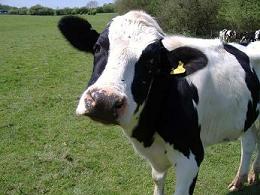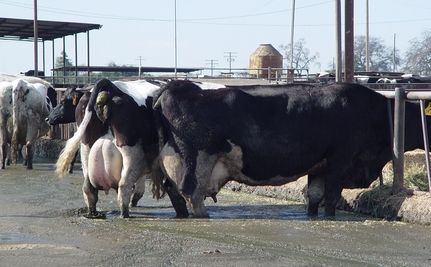
Animal Tracing, Food Contamination and the Unsanitary Conditions of US Meat Processing Plants
Rady Ananda
Jan. 4, 2010

Animal traceability is gaining governmental support in two key US beef markets, which may bolster reinvigoration of the National Animal Identification System in the United States. Though NAIS remains a despised voluntary program today, we may see its full implementation under S 510, the Food Safety Modernization Act.
Animal traceability is gaining governmental support in two key
Though NAIS remains a voluntary program despised by independent ranchers, we may see its full implementation under S 510, (fka HR 2749), the Food Safety Modernization Act (FSMA). A summary by the Congressional Research Service advises that S 510:
“Requires the Secretary of Agriculture to … improve the capacity of the Secretary to track and trace raw agricultural commodities,” and it “[r]equires the Secretary, acting through the Director of the Centers for Disease Control and Prevention (CDC), to enhance foodborne illness surveillance systems.”
Linn Cohen-Cole wrote a scathing critique of the FSMA in HR 2749: Totalitarian Control of the Food Supply. She believes that S 510 will mark “an end to
Behind Global Animal Tracing
The top markets for US beef are
In 2004,
|
|
Top markets for |
||||||||
|
(accounting for over 90% of total beef exports) |
|||||||||
|
Year |
|
|
|
|
|||||
|
Volume |
Value |
Volume |
Value |
Volume |
Value |
Volume |
Value |
||
|
(Million lbs. carcass weight) |
|
(Million lbs. carcass weight) |
|
(Million lbs. carcass weight) |
|
(Million lbs. carcass weight) |
|
||
|
|
|
|
|
||||||
|
($million) |
($million) |
($million) |
($million) |
||||||
|
|
|
|
|
||||||
|
2002 |
771 |
854 |
629 |
615 |
597 |
619 |
241 |
286 |
|
|
2003 |
918 |
1,182 |
586 |
623 |
587 |
754 |
227 |
309 |
|
|
2004 |
12 |
31 |
333 |
393 |
1 |
2 |
56 |
105 |
|
|
2005 |
17 |
50 |
464 |
584 |
1 |
3 |
106 |
194 |
|
|
2006 |
52 |
105 |
660 |
786 |
1 |
4 |
239 |
415 |
|
|
2007 |
159 |
294 |
586 |
732 |
78 |
124 |
339 |
575 |
|
|
2008 |
231 |
439 |
649 |
854 |
152 |
241 |
389 |
683 |
|
|
Source: USDA Economic Research Service, http://bit.ly/7z5oEx |
|||||||||
That all changed after the 2003 creation of a new voluntary Japan Agricultural Standard (JAS) program to certify the traceability of imported beef. Iowa State University reports:
“Results from consumer focus groups indicate that Japanese consumers will pay 20 percent more for domestic foods with specific safety assurances and production information. This response is generally supported by price differences at retail outlets.”
Japanese reluctance to buy cattle that was fed genetically modified feed and a steady stream of drugs has also created a booming organic market. By 2008, US beef exports to
By 2006, sixty-five nations, including South Korea, implemented full or partial bans on importing U.S. beef products, citing fears that testing for BSE lack rigor, per a USA Today opinion piece that condemns the USDA ban on private testing for BSE.
When
But Does Animal Tracing Protect the Food Supply?
Governments seem focused on animal tracing as the magic bullet to protect the food supply. In

Cows with rBGH-induced mastis stand in shit on factory farms
But animal tracing does not address food contamination caused by concentrated animal feeding operations (CAFOs), where thousands of animals are crammed into tiny stalls, barely able to move. Because of their close quarters, lack of exercise and sunlight, and an unnatural diet of genetically modified grains, diseases spread like wildfire. To counter this, factory farms give the animals heavy doses of antibiotics, creating super-virulent strains of “super bugs” that are antibiotic resistant.
Animal tracing also does not address the unsanitary conditions of meat processing plants, which have been deregulated under HACCP – the Hazard Analysis Critical Control Points program that removes independent inspections. Under HACCP, food processing plants monitor themselves.
In September, the Agricultural Appropriations conference committee cut funding by more than 60% for NAIS, a reduction of nearly two-thirds from the $14.6 million requested by the U.S. Department of Agriculture. This may be in response to the massive outcry by ranchers during the NAIS Listening Sessions earlier this year. Ranchers cited cost, privacy, and an unfair advantage to factory farms, which are required to tag only one out of 100,000 head.
The Farm to Consumer Legal Defense Fund claims that NAIS won’t achieve food safety. Instead, it suggests that we:
-
Decentralize the livestock industry and encourage local, diversified farms, which would increase animal health, food security, and food safety;
-
Increase inspections of imported animals and agricultural products and bar the entry of animals from countries with known disease problems; and
Improve enforcement of existing laws and inspections of large slaughterhouses and food processing facilities, including unannounced spot inspections at those large facilities.
Instead of animal tracing, the
Food safety can also be achieved by encouraging the spread and diversification of small farms. Promotion of local, organic food would invigorate local economies, improve the environment and increase public health. S 510 threatens small farms, with its over-reaching attempt at control of the food supply.
www.globalresearch.ca/index.php
